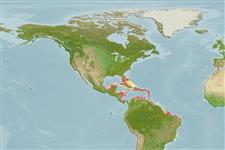Common names from other countries
Environment: milieu / climate zone / depth range / distribution range
экология
; солоноватоводный; пределы глубины 1 - 5 m (Ref. 108813). Tropical
Western Central Atlantic: Caribbean.
Length at first maturity / Size / Вес / Возраст
Maturity: Lm ? range ? - ? cm
White; crispy and crumbly mass. With elevated fistules-oscular tubes. Massive, papillated or tube.
Combination depth range: min from literature, max from estimate.
Life cycle and mating behavior
половая зрелость | размножение | нерест | икра | Fecundity | личинки
Members of the class Demospongiae are hermaphroditic. Life cycle: The zygote develops into parenchymella larva (free-swimming) before settling down on a substrate where it grows into a young sponge.
Основная ссылка
ссылки | координатор | соавторы
Zea, S., T.P. Henkel and J.R. Pawlik. 2009. (Ref. 81728)
Статус Красного Списка МСОП (Ref. 130435)
Статус СИТЕС (Ref. 108899)
Not Evaluated
Not Evaluated
Угроза для людей
Harmless
Использование человеком
| FishSource |
инструменты
дополнительная информация
Возраст/РазмерыростЗависимость между длиной и массой телаЗависимость между длинамиморфологияличинкичисленность
ресурсы в Интернет
Estimates based on models
Preferred temperature
(Ref.
115969): 26.2 - 28.3, mean 27.2 (based on 299 cells).
